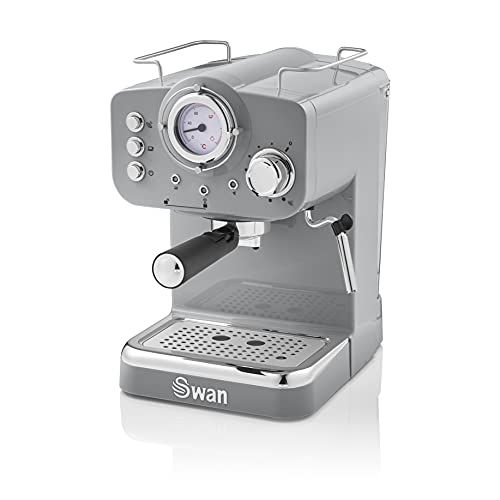How to Make Espresso Machine Coffee
Espresso machines can make an excellent cup of coffee, however it requires some additional setup and maintenance than a typical drip coffee maker. You must also grind and tamp the beans by yourself.
The most important ingredient in making espresso is pressure. Here's how an espresso machine operates: a heating vessel is used to heat water to a suitable temperature, then it pushes it through the grounds before pouring out the spouts.
Temperature
Espresso is produced by pushing hot water under pressure through finely ground coffee beans. The temperature of the water is crucial to the quality of the final shot. Low temperatures result in less extraction of the essential flavor compounds. The high temperatures can cause over extraction, which may cause bitter or burned taste.
The ideal temperature range for espresso is 195 to 205 degrees F. This temperature can be achieved by using a grouphead designed to maintain the same temperature and stability throughout the brewing process. The E61 is the most sought-after group head, as it offers temperature stabilty, pre-infusion capability, and lever control.
It is important to take into account the temperature when you adjust your espresso machine to different roasts or brew ratios. This will impact the extraction yield as well as the crema. The optimal temperature will depend on the specific roast and bean but the general rule is that lighter roasts and greater brew ratios require higher temperatures than dark roasts and lower ratios of brew. A good thermocouple is important to ensure the temperature at a constant level.
Pressure
During the brewing procedure, espresso machine coffee is pushed through finely ground coffee grounds that have been put through a tamper. This creates chemical reactions that extract flavors, oils and other soluble components from the beans. The drink that is produced is typically richer and more flavorful.
The ideal espresso machine pressure is nine bar of pressure, which is equivalent to the atmospheric pressure at sea level. This is due to the fact that it's at this pressure that the soluble compounds in espresso beans are the easiest to extract.
Some espresso machines advertise up to 20 bars of pressure. While these machines may reach these levels of pressure however, they might not be capable of maintaining the pressure during the extraction.
To put that in visit the next internet site For a better understanding, one bar is equivalent to 32 pounds per square inch PSI of a car tire. It's also more than four times the amount of pressure that a professional cyclist uses when pumping up their bicycle tires. Any serious home barista must to be able control the pressure of their espresso machine and make consistent espressos.
Water
The water that you use in your espresso maker is among the most important elements of a great cup coffee. The right water allows your beans to extract their maximum potential. However the wrong kind of water can cause issues like clogging pipes and damage to your expensive machine.
To get the most espresso extraction, you should choose an organic spring with a high mineral content. This water will elevate the flavor of your coffee without the chalky mineral traces that are found from tap or bottled water. This is an excellent alternative to reverse osmosis, which could be too pure and cause flavor problems.
You should not use a water filtering system that removes the mineral content of your tap water. This could cause taste and extraction issues. One option is to buy an instrument for testing water, which will provide you with the water hardness in your area. This can then be used to locate a filtration system that will provide the right water specs for your espresso machine.
Beans

The majority of coffee lovers get very involved with the whole process of making espresso. They obsess over a number of variables, including temperature, water pressure beans, milk viscosity, and other factors. If one of these variables is slighty off, the entire shot could taste bad.
The beans used are the most important factor when it comes to espresso. It is often believed that only certain kinds of beans are suited for espresso. While some beans are better designed for specific uses but any bean that is roasted can be used to make espresso. The main difference between espresso beans and regular coffee beans is that espresso beans are roast for longer and tipycally over the second crack, which gives them more of a dark appearance and makes them more soluble in water.
The best espresso beans are generally medium roasted or dark roasted, which gives the espressos their distinctive richness and vigor. But, it's possible to make great espresso using light roast beans, especially when these beans are pre-ground (for convenience in an espresso machine).
Milk
Espresso and milk are a classic combination. Not only does the coffee increase energy levels, but the steaming milk helps balance the bitterness of espresso and also adds a wonderful creaminess. This is one of the best pairings for a meal!
If you choose to buy an espresso machine that also has the ability to create cappuccino or latte make sure to take a look at how simple it is to use. The best espresso machines feature an ice jug that can be filled with cold or hot milk along with a steam wand as well as an espresso portafilter to pull the shot. Certain models also come with an integrated grinder or tamper.
The steam wand needs to be purged before using it for the first time in a day (or after each cup of espresso) to clear out any condensed water. The process takes only 30 seconds, but it's essential to keep your machine running smoothly. Inability to purge could cause a bitter taste or build-up of bacteria that can affect the flavor and aroma of your beverages. It's not difficult to do and should be a part of your routine maintenance.
